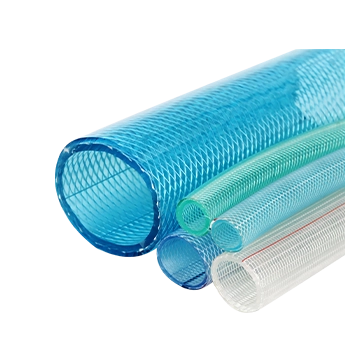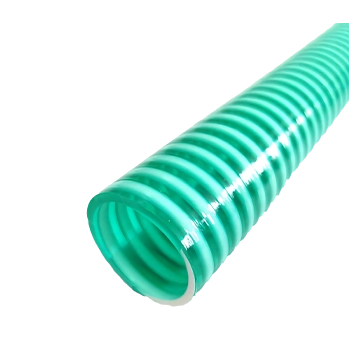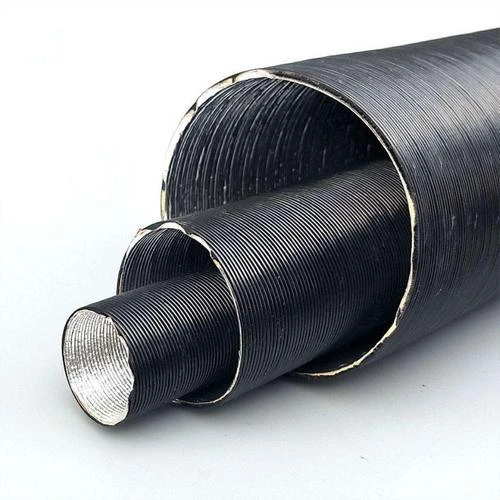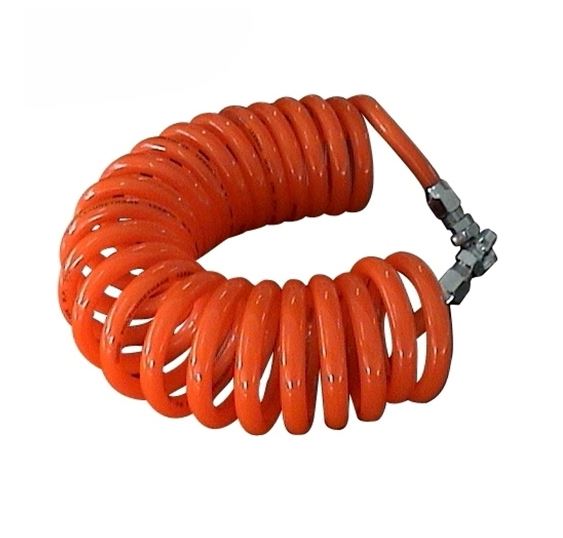Polyurethane Pneumatic Tubing: Flexible, Durable Air Hoses
The Ascendance of Polyurethane Pneumatic Tubing in Industrial Automation
In the intricate landscape of modern industrial automation and control systems, the choice of pneumatic conveying components profoundly impacts operational efficiency, system longevity, and overall reliability. Among the myriad options available, polyurethane pneumatic tubing has emerged as a preferred solution, lauded for its exceptional combination of flexibility, abrasion resistance, and chemical compatibility. This comprehensive overview delves into the critical aspects of this essential industrial component, from its manufacturing intricacies and technical specifications to its diverse application scenarios and strategic advantages for B2B stakeholders.
The demand for robust, high-performance, and adaptable fluid conveyance systems is ever-growing, driven by advancements in robotics, factory automation, and specialized industrial processes. Understanding the nuances of polyurethane pneumatic tubing is paramount for engineers, procurement specialists, and operational managers aiming to optimize their pneumatic circuits and achieve peak performance.
Industry Trends and Market Dynamics for PU Air Hoses
The global market for pneumatic components, including polyurethane air tubing, is experiencing steady growth, propelled by the expanding manufacturing sector, increased adoption of automation across various industries, and the continuous push for energy efficiency. Key trends influencing the market include:
- Miniaturization and Lightweighting: As industrial robots and automated machinery become more compact, there is a rising need for smaller diameter, highly flexible, and lightweight tubing solutions that do not compromise performance.
- Enhanced Performance Requirements: Industries are demanding tubing that can withstand higher pressures, wider temperature ranges, and more aggressive chemical environments, pushing manufacturers to innovate material compositions.
- Sustainability and Compliance: Growing environmental regulations and corporate social responsibility initiatives are driving the adoption of materials that are REACH and RoHS compliant, and products with longer service lives to reduce waste.
- Smart Manufacturing (Industry 4.0): Integration of sensor technology and predictive maintenance strategies necessitates tubing solutions that are robust and capable of sustained operation in data-driven environments.
- Customization: Standard off-the-shelf tubing often falls short for specialized applications. The market trend is towards highly customized solutions in terms of color, multi-lumen configurations, and specific material blends to meet unique client needs.
These trends underscore the importance of material science in evolving the capabilities of pu air hose technology to meet future industrial demands.
Manufacturing Process of High-Performance Polyurethane Pneumatic Tubing
The production of superior polyurethane pneumatic tubing involves a meticulous process designed to ensure consistent quality, precise dimensions, and optimal performance characteristics. The primary material utilized is Thermoplastic Polyurethane (TPU), a polymer known for its excellent elasticity, transparency, and resistance to oils and greases.
Process Flow Overview:
- Raw Material Preparation: High-grade TPU pellets are carefully selected, ensuring purity and consistent melt flow index. These pellets undergo a drying process to remove any moisture, which is critical to prevent degradation during extrusion and maintain polymer integrity.
- Extrusion: The dried TPU pellets are fed into a single-screw extruder where they are heated and melted into a homogenous liquid. This molten polymer is then forced through a precisely machined die, forming a continuous tube. The extrusion process is tightly controlled to maintain consistent wall thickness and outer diameter.
- Cooling and Sizing: Immediately after exiting the die, the extruded tube enters a water bath or air-cooling chamber. This controlled cooling process solidifies the tubing while maintaining its dimensional stability. Vacuum sizing may be employed to ensure precise outer diameter and roundness.
- Traction and Winding: A puller mechanism gently draws the tubing at a consistent speed, preventing stretching or deformation. The continuous tubing is then wound onto spools or cut into precise lengths, depending on specific order requirements.
- Quality Control and Testing: Throughout the entire process, and especially post-production, rigorous testing is conducted. This includes dimensional checks (OD, ID, wall thickness), burst pressure testing (e.g., in accordance with ISO 14743 or ASTM D2843), tensile strength, elongation at break, flexibility, and abrasion resistance. Material hardness (Shore A) is also verified.
- Packaging: Finished tubes are carefully packaged to prevent contamination or damage during transport and storage.
Key Advantages in Typical Application Scenarios:
- Energy Saving: The smooth inner bore of polyurethane tubing minimizes pressure drops, contributing to efficient air flow and reduced energy consumption in pneumatic systems.
- Corrosion Resistance: TPU's inherent resistance to a wide range of chemicals, oils, and greases makes it ideal for harsh industrial environments, extending service life and reducing maintenance.
- Long Service Life: With superior abrasion resistance and excellent hydrolytic stability, PU tubing withstands dynamic stress and environmental exposure far longer than traditional materials.
Target industries benefiting significantly from these advantages include petrochemical, metallurgy, automotive manufacturing, robotics, food processing, and water supply & drainage systems.
Technical Specifications and Performance Parameters
The robust performance of pu air pipe is defined by a range of critical technical parameters that engineers must consider for optimal system design. These specifications ensure compatibility, safety, and longevity in diverse operational conditions.

Key Specifications:
- Hardness (Shore A): Typically ranging from 85A to 98A, this indicates the material's resistance to indentation. Softer tubing offers greater flexibility, while harder tubing provides better abrasion resistance and pressure ratings.
- Operating Pressure: The maximum continuous pressure the tubing can withstand without failure, specified at a particular temperature (e.g., 20°C). This is crucial for system integrity.
- Burst Pressure: The pressure at which the tubing will rupture. A safety factor (typically 3:1 or 4:1) is applied to the operating pressure.
- Temperature Range: The ambient and media temperature range within which the tubing maintains its mechanical properties and performance. Common ranges are -20°C to +60°C, but specialized formulations can extend this.
- Bend Radius: The minimum radius to which the tubing can be bent without kinking or damage. A smaller bend radius signifies greater flexibility, vital for confined spaces or dynamic applications.
- Chemical Resistance: The ability of the tubing material to resist degradation when exposed to various chemicals, oils, solvents, and fuels. Polyurethane generally offers good resistance to non-polar solvents and petroleum-based products.
- Abrasion Resistance: A key advantage of polyurethane, its high resistance to wear and tear from friction, especially in applications involving movement or abrasive environments.
Table 1: Typical Polyurethane Pneumatic Tubing Specifications (Example Data)
| Parameter | Standard Value Range | Unit |
|---|---|---|
| Material | Thermoplastic Polyurethane (TPU) | - |
| Hardness (Shore A) | 85-98 | Shore A |
| Operating Pressure (at 20°C) | Up to 1.0 - 1.5 MPa (10-15 bar) | MPa / bar |
| Burst Pressure | 3x - 4x Operating Pressure | MPa / bar |
| Temperature Range | -20°C to +60°C (standard) | °C |
| Tensile Strength | 35-50 MPa | MPa |
| Elongation at Break | 400-600% | % |
| Abrasion Resistance (DIN 53516) | 35-50 mm³ | mm³ |
Application Scenarios and Technical Advantages
The unique blend of properties offered by polyurethane air tubing makes it an indispensable component across a vast spectrum of industrial applications. Its technical advantages address common pain points associated with traditional pneumatic materials, leading to improved operational performance and reduced total cost of ownership.
Typical Application Scenarios:
- Robotics and Automation: Its exceptional flexibility and kink resistance are critical for robotic arms and automated machinery with constant, dynamic movements. The tubing can endure millions of flex cycles without degradation, ensuring consistent operation.
- Pneumatic Tool Lines: In manufacturing and assembly, PU tubing connects air tools, offering durability against dragging, snagging, and impacts, outperforming less robust materials.
- Material Handling Equipment: Used in pick-and-place systems, vacuum lifters, and conveyor lines where tubing may be exposed to abrasive dust or frequent contact with moving parts.
- Chemical Transfer (Low Pressure): Its good chemical resistance makes it suitable for conveying select chemicals, inks, and solvents in low-pressure applications, such as painting booths or printing presses.
- Clean Room Environments: Certain grades of PU tubing are formulated to be low-leaching and particulate-free, making them suitable for semiconductor manufacturing, medical device assembly, and pharmaceutical production.
- Food and Beverage Processing: FDA-compliant polyurethane options are used for food contact applications, offering hygiene, chemical resistance to cleaning agents, and resilience.
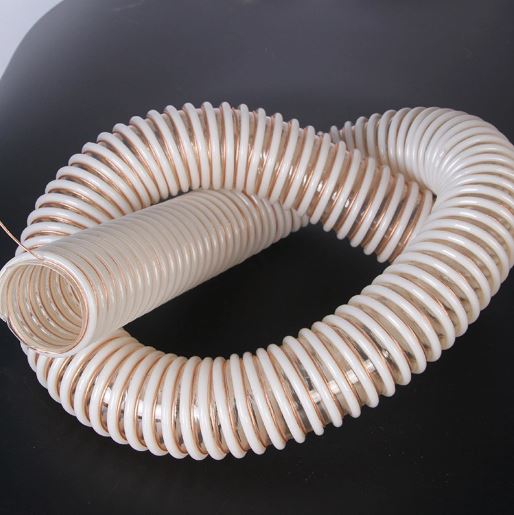
Core Technical Advantages:
- Superior Flexibility: Allows for tighter bend radii without kinking, facilitating installation in confined spaces and accommodating dynamic applications where tubing undergoes constant flexing. This reduces stress on fittings and connections.
- Exceptional Abrasion Resistance: Outperforms most other plastic tubing materials, making it ideal for applications involving friction, dragging, or contact with rough surfaces. This extends tubing life and reduces maintenance.
- Excellent Kink Resistance: Maintains its open bore even when tightly bent, ensuring uninterrupted air flow and preventing system downtime.
- Good Chemical Compatibility: Resists many oils, greases, fuels, and some common industrial solvents, offering reliability in contaminated environments.
- Broad Temperature Range: Performs reliably across a typical industrial temperature spectrum, maintaining flexibility in cold conditions and stability in moderate heat.
- Low Permeability: Offers good barrier properties against air and moisture, maintaining system pressure and preventing contamination of conveyed media.
- Hydrolysis Resistance: Certain PU formulations provide enhanced resistance to degradation in humid or aqueous environments, broadening their application scope.
Vendor Comparison and Customized Solutions
Selecting the right supplier for polyurethane pneumatic tubing is as crucial as understanding the product itself. A strategic vendor partnership ensures not only product quality but also long-term support and the availability of tailored solutions.
Key Criteria for Vendor Comparison:
- Material Quality and Consistency: Does the vendor use virgin, high-grade TPU, and implement stringent quality control at every stage of manufacturing? Consistency directly impacts performance and reliability.
- Certifications and Compliance: Look for ISO 9001 certified manufacturers. For specific applications, compliance with RoHS, REACH, FDA, or UL standards is critical.
- Product Range and Availability: A comprehensive catalog covering various IDs, ODs, colors, and durometers, coupled with strong inventory management, is a good indicator of reliability.
- Technical Support and Expertise: A vendor that provides detailed technical data, application engineering support, and can advise on optimal product selection adds significant value.
- Customization Capabilities: The ability to produce tubing with specific properties (e.g., anti-static, flame retardant, multi-lumen, custom colors, different shore hardness) is vital for specialized industrial needs.
- Years of Service and Client Portfolio: A proven track record and a portfolio of satisfied clients in relevant industries speak volumes about a vendor's experience and authoritativeness.
Table 2: Material Comparison for Pneumatic Tubing (PU vs. Nylon vs. PVC)
| Characteristic | Polyurethane (PU) | Nylon (PA) | Polyvinyl Chloride (PVC) |
|---|---|---|---|
| Flexibility | Excellent | Good | Good (can stiffen with age/cold) |
| Abrasion Resistance | Superior | Good | Fair |
| Pressure Rating | High (up to 15 bar) | Very High (up to 20 bar+) | Moderate (up to 10 bar) |
| Temperature Range | -20°C to +60°C | -40°C to +80°C | 0°C to +50°C |
| Chemical Resistance | Good (oils, fuels, some solvents) | Excellent (solvents, many chemicals) | Good (acids, alkalis, poor vs. solvents) |
| Cost | Medium to High | Medium | Low |
| Kink Resistance | Excellent | Good | Fair |
The Power of Customized Solutions:
For specialized industrial applications, off-the-shelf tubing may not suffice. Leading manufacturers offer extensive customization options, including:
- Multi-Lumen Tubing: Consolidating multiple lines into a single, organized unit for complex pneumatic circuits.
- Custom Colors: For easy circuit identification and aesthetic integration.
- Specific Hardness/Durometer: Tailoring flexibility and pressure resistance for niche requirements.
- Special Additives: Such as UV stabilizers for outdoor use, flame retardants for safety-critical areas, or anti-static compounds for ATEX environments.
- Spiral Coils and Pre-formed Shapes: For applications requiring retractable or specific routing, minimizing entanglement and improving aesthetics.
- Bonded Tubing: Several tubes bonded together for neat, organized routing.
Engaging with a vendor capable of providing these tailored solutions ensures that the pu air hose perfectly matches the operational demands of the application, thereby maximizing performance and minimizing installation complexities.
Application Case Studies: Real-World Impact
The practical benefits of high-quality polyurethane pneumatic tubing are best illustrated through real-world applications where its unique properties have solved critical industrial challenges.

Case Study 1: Automotive Assembly Plant Robotics
A major automotive manufacturer faced recurring issues with pneumatic lines on their robotic welding and painting arms. Traditional Nylon tubing, while rigid, was prone to kinking and stress cracks due to constant flexing in dynamic movements, leading to frequent downtime and high replacement costs.
- Solution: Implementation of flexible polyurethane pneumatic tubing with a Shore A hardness of 90A, capable of withstanding millions of flex cycles.
- Outcome: Reduced unplanned downtime by 35%, extended tubing service life by over 200%, and significantly lowered maintenance expenses. The superior flexibility allowed for more intricate robotic movements without compromising air flow.
Case Study 2: Chemical Dosing Systems in Water Treatment
A municipal water treatment facility required a reliable solution for conveying low-pressure chemical reagents (e.g., flocculants, chlorine solutions) in their dosing systems. PVC tubing showed degradation and hardening when exposed to certain chemicals over time, resulting in leaks and material contamination.
- Solution: Installation of chemically resistant pu air pipe, specifically engineered with enhanced hydrolytic stability and compatibility for a broader range of dilute chemical solutions.
- Outcome: Eliminated chemical leaks and tubing degradation issues, ensuring consistent and safe chemical delivery. The superior service life reduced the frequency of tube replacements by over 50%, contributing to operational stability and environmental compliance.
Case Study 3: Packaging Machinery in Food Processing
A food packaging company needed pneumatic tubing for actuators in their high-speed sorting and packaging lines. The environment was damp, often exposed to cleaning agents, and required materials compliant with food safety regulations. Standard industrial tubing often failed due to hydrolysis and lacked necessary certifications.
- Solution: Implementation of FDA-compliant polyurethane pneumatic tubing that offered excellent hydrolytic stability and resistance to common cleaning chemicals.
- Outcome: Ensured compliance with food safety standards while providing robust performance in a challenging, wash-down environment. The tubing's durability led to consistent machine uptime and minimized the risk of contamination, enhancing overall product safety and production efficiency.
Ensuring Trust and Reliability: Kebing Hose's Commitment
At Kebing Hose, our commitment to delivering high-performance PU Anti-Sprial Hose is underpinned by rigorous adherence to international standards, extensive testing protocols, and a customer-centric support framework.
Authoritativeness through Certifications and Quality Control:
- ISO 9001 Certified Manufacturing: Our production facilities operate under the stringent guidelines of ISO 9001, ensuring consistent quality management from raw material sourcing to final product inspection.
- Compliance Standards: Our polyurethane products comply with relevant international directives such as RoHS (Restriction of Hazardous Substances) and REACH (Registration, Evaluation, Authorisation and Restriction of Chemicals), underscoring our commitment to environmental responsibility and user safety.
- Advanced Testing Protocols: Every batch of tubing undergoes comprehensive testing, including burst pressure tests (exceeding industry safety factors), tensile strength and elongation tests, hardness measurements, and accelerated aging tests to predict long-term performance. We also conduct specific tests for abrasion resistance (e.g., according to DIN 53516).
- Years of Expertise: With decades of experience in hose manufacturing, Kebing Hose has established itself as a trusted partner for B2B clients worldwide, serving diverse sectors including petrochemical, automotive, and general industrial automation.
Trustworthiness: FAQ, Lead Time, Warranty, and Support
Transparency and reliable support are cornerstones of our client relationships.
Frequently Asked Questions (FAQ):
- Q1: What is the primary difference between PU, Nylon, and PVC pneumatic tubing?
- A1: PU tubing offers superior flexibility, excellent abrasion, and kink resistance. Nylon provides higher pressure ratings and better chemical resistance to certain solvents. PVC is the most economical but has lower pressure ratings, limited temperature range, and less flexibility, especially in cold conditions. PU strikes an excellent balance of properties for most dynamic industrial applications.
- Q2: How do I select the correct inner and outer diameter for my application?
- A2: Selection depends on the required flow rate, operating pressure, and available space. A larger inner diameter (ID) allows for higher flow rates, while the outer diameter (OD) must match your fittings. Consult our technical team or product datasheets, and consider pressure drop calculations for long runs.
- Q3: Can Kebing Hose provide tubing for high-temperature environments?
- A3: Standard polyurethane pneumatic tubing typically operates up to 60°C. For continuous high-temperature applications (e.g., above 80°C), we recommend considering specialized materials like certain grades of Nylon or exploring our custom formulations designed for elevated thermal performance.
- Q4: What are the typical lead times for bulk orders?
- A4: Standard lead times for common specifications range from 2-4 weeks. For large volume or customized orders, lead times may vary. We maintain robust inventory levels and offer expedited production options for urgent requirements. Please contact our sales team for precise lead time estimates based on your specific order.
- Q5: What is your warranty policy for polyurethane pneumatic tubing?
- A5: We provide a standard 12-month warranty against manufacturing defects from the date of purchase. Our commitment extends to ensuring products meet their published specifications under normal operating conditions. Detailed warranty terms are available upon request.
Lead Time & Fulfillment:
We understand the importance of timely delivery in industrial operations. Our advanced logistics and production planning ensure efficient order processing and dispatch. We offer various shipping options to meet your project timelines, from standard freight to expedited services for critical needs.
Warranty Commitments:
Kebing Hose stands behind the quality and performance of our PU Anti-Sprial Hose. Our warranty covers material and workmanship defects, providing our clients with peace of mind and confidence in their investment.
Customer Support:
Our dedicated technical support team is available to assist with product selection, installation guidance, and troubleshooting. We offer comprehensive after-sales service, including product returns and technical consultations, ensuring that your pneumatic systems operate at peak efficiency throughout their lifecycle.

Conclusion: The Strategic Choice for Modern Pneumatic Systems
The evolving demands of industrial automation necessitate components that not only perform reliably but also contribute to overall system efficiency and longevity. Polyurethane pneumatic tubing stands out as a superior choice, offering an unparalleled combination of flexibility, abrasion resistance, chemical compatibility, and pressure endurance. Its versatility makes it suitable for a vast array of challenging applications, from high-speed robotics to sensitive chemical transfer systems.
By prioritizing material quality, stringent manufacturing processes, and comprehensive quality control, manufacturers like Kebing Hose deliver products that meet and exceed the expectations of B2B decision-makers and engineers. Investing in high-quality pu air hose is a strategic decision that leads to reduced downtime, lower maintenance costs, enhanced operational safety, and ultimately, a more robust and efficient industrial infrastructure. As industries continue to advance, the role of specialized, high-performance pneumatic components will only grow in importance, solidifying polyurethane pneumatic tubing's position as a cornerstone of modern industrial design.
References
- ISO 14743: Pneumatic fluid power – Compression-type tube fittings for fluid power – Performance requirements. International Organization for Standardization.
- ASTM D2843-99: Standard Test Method for Density of Smoke from the Burning or Decomposition of Plastics. ASTM International.
- DIN 53516: Testing of rubber and elastomers; determination of abrasion resistance. Deutsches Institut für Normung.
- Federal Register: Code of Federal Regulations, Title 21, Food and Drugs, Part 177, Indirect Food Additives: Polymers. U.S. Government Publishing Office.
- European Chemicals Agency (ECHA) – REACH Regulation (EC) No 1907/2006.
- European Parliament and Council Directive 2011/65/EU on the restriction of the use of certain hazardous substances in electrical and electronic equipment (RoHS 2).
-
Durable PVC Air Hoses: Flexible & Reliable Industrial SolutionsNewsAug.29,2025
-
PVC Suction Hoses: Flexible, Durable Fluid Transfer SolutionsNewsAug.28,2025
-
Advanced Corrugated Pvc Hose Technology for Modern Industrial NeedsNewsAug.22,2025
-
Premium Fire Water Hose Solutions for Global IndustriesNewsAug.22,2025
-
Industrial Suppliers Guide to Premium Double Welding Hose SolutionsNewsAug.22,2025
-
Premium PU Pneumatic Hose Solutions for Industrial ApplicationsNewsAug.22,2025



